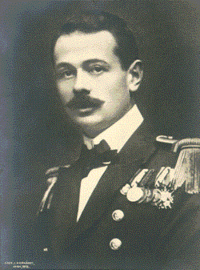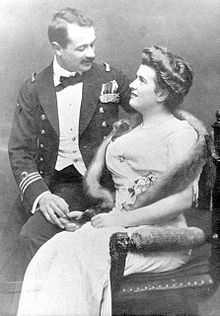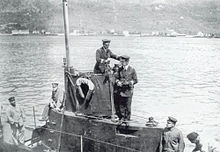Georg Ritter von Trapp - Picture
More about World War 1

|
|
Georg Ritter von Trapp
Georg von Trapp
 Born: April 4, 1880(1880-04-04)
Born: April 4, 1880(1880-04-04)
Picture - Von Trapp and Agathe Whitehead circa 1910
Korvettenkapitx¤n Georg Ludwig Ritter von Trapp (April 4, 1880 - May 30, 1947), known as Baron von Trapp, was an Austro-Hungarian Navy officer. His exploits at sea during the World War I earned him numerous decorations, including the prestigious Military Order of Maria Theresa. The story of his family served as the inspiration for the musical The Sound of Music.
Birth and naval career
Georg Ludwig Ritter von Trapp was born in Zara, Dalmatia, then part of the Austro-Hungarian Empire, now in Croatia. His father, Fregattenkapitx¤n August Trapp, was a naval officer who had been elevated to the Austrian nobility in 1876 which entitled him and his descendants to the style of Ritter (Knight) von in the case of male and von in the case of female offspring.

Picture - On duty aboard SMU-5
August Ritter von Trapp died in 1884, when Georg was four. His mother was Hedwig Wepler. Von Trapp's older sister was the Austrian artist Hede von Trapp. His brother, Werner von Trapp, died in World War I in 1915.
In 1894, von Trapp followed in his father's footsteps and entered the Austro-Hungarian Navy, entering the naval academy at Rijeka (Fiume). He graduated four years later and completed two years of follow-on training voyages including a trip to Australia. In 1900 he was assigned to the armored cruiser Kaiserin und Kx¶nigin Maria Theresia and was decorated for his performance during the Boxer Rebellion. In 1902 he passed the officer's examination. He was fascinated by submarines, and in 1908 he seized the opportunity to be transferred to the newly-formed U-boot-Waffe. In 1910 he was given command of the newly-constructed U-6, which was christened by Agathe Whitehead, granddaughter of the Englishman Robert Whitehead, inventor of the torpedo. He commanded U-6 until 1913.
On April 22, 1915, von Trapp took command of U-5 and conducted nine combat patrols. While in command of the U-5 he sank:
the French armored cruiser Léon Gambetta at 39.30N, 18.15E on April 21, 1915, 25 kilometres (16 mi) south of Cape Santa Maria di Leuca,
the Italian submarine Nereide at 42.23N, 16.16E on August 5, 1915, 250 metres off Pelagosa (Palagruža) Island.
He captured:
the Greek steamer Cefalonia off Durazzo on August 29, 1915.
He is sometimes credited with sinking the Italian troop transport Principe Umberto, but in reality, this was sunk by U-5 under von Trapp's successor Friedrich Schlosser (1885-1959) on June 8, 1916, after von Trapp was transferred to the U-14.
On October 14, 1915, he was transferred to the captured French submarine Curie, which the Austrian Navy redesignated U-14. While in command of U-14, he sank:
the British tanker Teakwood at 36.39N, 21.10E on April 28, 1917,
the Italian steamer Antonio Sciesa at 36.39N, 21.15E on May 3, 1917,
the Greek steamer Marionga Goulandris at 35.38N, 22.36E on July 5, 1917,
the French steamer Constance at 36.51N, 17.25E on August 23, 1917,
the British steamer Kilwinning at 35.26N, 16.30E on August 24, 1917,
the British steamer Titian at 34.20N, 17.30E on August 26, 1917,
the British steamer Nairn at 34.05N, 19.20E on August 28, 1917,
the Italian steamer Milazzo at 34.44N, 19.16E on August 29, 1917,
the British steamer Good Hope at 35.53N, 17.05E on October 18, 1917,
the British steamer Elsiston at 35.40N, 17.28E on October 18, 1917,
the Italian steamer Capo Di Monte at 34.53N, 19.50E on October 23, 1917.
He conducted ten more war patrols, until, in May 1918, he was promoted to Korvettenkapitx¤n (equal to Lieutenant Commander) and given command of the submarine base in the Gulf of Kotor.
At the end of World War I, von Trapp's wartime record stood at 19 war patrols; 11 cargo vessels totalling 45,669 tons sunk, plus the Léon Gambetta and Nereide and 1 cargo vessel captured. Among other honors, he received the Knight's Cross of the Military Order of Maria Theresa.
The end of the First World War saw the defeat and collapse of the Austro-Hungarian Empire. In the process, Austria was reduced in size to its German-speaking core - losing its seacoast - and had no further need for a navy, leaving von Trapp without a job.
First marriage
Von Trapp was first married to Agathe Whitehead, who was a niece of St John Brodrick, 1st Earl of Midleton and a granddaughter of Robert Whitehead, the inventor of the torpedo. It was she who had christened the U-boat U-6, his first command.
Agathe's inherited wealth sustained the couple and permitted them to start a family. Their first child, Rupert, was born on November 1, 1911, at Pola. The marriage produced six more children: Agathe, also born at Pola; Maria Franziska; Werner; Hedwig; and Johanna; all born at Zell am See at the family home-the Erlhof--and Martina, born at Klosterneuburg at the family home, the Martinsschlx¶ssel.
On September 3, 1922, Agathe Whitehead died of scarlet fever contracted from her daughter Agathe. The family purchased a villa in Aigen, a suburb of Salzburg, and moved in 1924. About 1926 Maria Franziska was recovering from an illness and was unable to attend school, so von Trapp hired Maria Augusta Kutschera, from the nearby Nonnberg Abbey, as a tutor.
Second marriage
Von Trapp, 47, married Maria, 22, on November 26, 1927. They had three children: Rosmarie, born February 8, 1929, in Salzburg, Austria; Eleonore, born May 14, 1931, in Salzburg; and Johannes, born January 17, 1939, in Philadelphia, bringing the total number of von Trapp's children to ten.
Later life
In 1935, von Trapp's money, inherited from his first wife, was invested in a bank in England. At that time, however, Austria was under economic pressure from a hostile Germany, and Austrian banks were in a precarious position. To help a friend in the banking business, Auguste Caroline Lammer (1885-1937), von Trapp withdrew most of his money from London and deposited it in an Austrian bank; unfortunately, it failed, wiping out most of the family's fortune. As Maria further indicates in her book, von Trapp was thoroughly demoralized and depressed at this turn of events, but was unable to engage in other gainful activities, believing that it was beneath the dignity of the family to sing in public or otherwise work for a living. Prior to the loss of the family fortune, the family had engaged in singing as a hobby.
Faced with an impossible situation of little or no money and a husband incapable of providing for her or for the family, Maria took charge and began to make arrangements for the family to sing at various events as a way of earning a livelihood. At about that time, a Catholic priest, Franz Wasner, around Maria's age, came to live with them and became the group's musical director. Maria also entrusted the priest with management of the family's finances as treasurer of the Trapp Family Austrian Relief fund.
Around 1936 Lotte Lehmann heard the family sing, and she suggested they perform paid concerts. When the Austrian Chancellor Kurt von Schuschnigg heard them on the radio, he invited them to perform in Vienna.
According to Maria von Trapp's memoirs, Captain von Trapp found himself in an awkward situation in 1936. He had been offered a prestigious commission in Germany's naval forces. Already anti-Nazi, he chanced to observe Adolf Hitler and other Nazi luminaries behaving crudely in a Munich restaurant, which sealed his decision to turn down the offer. Contrary to the plot of The Sound of Music, von Trapp was in no danger of being forced to join Hitler's navy as Austria was not yet under German control. The incident still drew the Trapps' attention to the growing political situation. They decided to leave Austria.
The family left Austria for Italy by train ((not by hiking the mountains to Switzerland as in the The Sound of Music. They sailed to the United States for their first concert tour and went back to Europe to tour Scandinavia in 1939. During this time, they went back to Salzburg for a few months before returning to Sweden to finish the tour. From there, they traveled to Norway to begin the trip back to the United States in September 1939.
After living for a short time in Merion, Pennsylvania, where they welcomed their youngest child, Johannes, the family settled in Stowe, Vermont, in 1941. They purchased a 660-acre (2.7 km) farm in 1942 and converted it into the Trapp Family Lodge. They built a home which they named Cor Unum (One Heart).
In January 1947, Major General Harry J. Collins turned to the von Trapp family in the USA pleading for help for the Austrian people, having seen the residents of Salzburg suffer when he had arrived there with the famed 42nd Rainbow Division after World War II. The Trapp Family founded the Trapp Family Austrian Relief, Inc.
Von Trapp died of lung cancer on May 30, 1947, in Stowe, Vermont.
More aircraft.
Source: WikiPedia